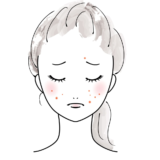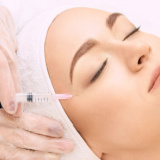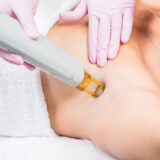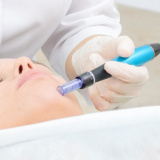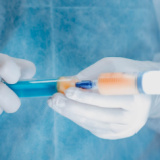Botox Information Page" for patients suffering from facial wrinkles, gills, hyperhidrosis, stiff shoulders, etc.
About Botox injection at Kamogawa Clinic (Osaka/Tenroku):.
This "Botox Information Page" explains the mechanism of action of Botox, indications for Botox treatment, and actual treatment methods.
About Botox
Botox is a product based on botulinum toxin and was developed by the American company Allergan. This formulation was originally made from a toxin produced by the bacterium botulinum, and was approved by the FDA in the United States in 2002 for the treatment of expression wrinkles. In Japan, it was approved by the Ministry of Health, Labour and Welfare in 2009 and is the only botulinum toxin product partially covered by insurance.
Botox injections are a widely used treatment in the field of cosmetic medicine and derive their name from the name of the product. This product is compared to many generic products and has the status of a brand name product. The treatment effect is not permanent and requires repeated treatments. Therefore, for those who are concerned about cost, generic products made in Korea such as Rhythotox®, Botulax®, and Navota® may be recommended.
The term Botox has become a common noun, and its performance and recognition are very high. However, there are many other products from other companies with similar effects, each chosen for specific needs. The main indications for Botox injections are not limited to the realm of cosmetic medicine, but its medical use is also expanding to include the treatment of excessive sweating and myotonia.
At the Kamogawa Clinic Tenroku in Tenjinbashi 6-chome, Kita-ku, Osaka, we offer Botox by Allergan and Rhythotox® made in Korea.
The mechanism of action of Botox
Botulinum toxin, commonly known as Botox, is a very potent toxin produced by the bacterium botulinum. This toxin is classified into seven types, from A to G. Type A is one of the most potent toxins in nature and can kill approximately 10 million people with just 1 gram. However, when used for medical or cosmetic purposes, very small amounts are used, keeping it safe.
Botulinum toxin's primary mechanism of action is to inhibit the release of acetylcholine at the neuromuscular junction. Acetylcholine is an important neurotransmitter that triggers muscle contraction, and when its release is blocked, muscles are unable to receive and move the proper signals. This is used to relieve excessive contraction and tension in the muscles and prevent wrinkle formation.
The application of Botox is not limited to cosmetic medicine, but has also expanded to medical uses to relieve excessive muscle tension and spasms. For example, it can be used in treatments to reduce excessive sweating or to relieve chronic muscle pain. Recent studies suggest that Botox may also affect other functions of the nervous system, and further research is expected to lead to the development of new treatments.
Thus, the action of botulinum toxin at the neuromuscular junction makes it possible to selectively paralyze the targeted muscle, which has many therapeutic benefits.
Indications for Botox treatment
Botox injections (botulinum toxin) is a medical technology that offers a wide variety of therapeutic benefits. The main indications are as follows
- Elimination of expression wrinkles: Injections into the facial muscles can be used to prevent and improve wrinkles on the face, such as horizontal forehead wrinkles when the eyes are wide open, wrinkles between the eyebrows that form involuntarily, and wrinkles at the corners of the eyes when smiling.
- Improvement of gills and small face effect: If the masseter muscle is overdeveloped (e.g., due to a strong bite during mastication or unconscious teeth clenching), Botox can be injected into the masseter muscle to decrease the bite force and reduce the size of the masseter muscle, resulting in a small face effect.
- Angle of mouth elevation effect: When the muscles that form the corners of the mouth have a strong downward pull, Botox can be injected to relax these muscles, causing the corners of the mouth to naturally turn upward, creating an attractive mouth.
- Gummy Smile Improvement: A gummy smile, in which the upper gums are excessively exposed when smiling, may be improved by injecting Botox into the muscle that lifts the upper lip.
- Lifting effect: Injecting Botox into the broad neck muscles improves sagging of the face and wrinkles in the neck, resulting in sharper facial lines.
- Improvement of hyperhidrosis: Because Botox inhibits the action of sweat glands, it can be injected into the armpits, palms, and forehead to decrease sweat production in people suffering from hyperhidrosis.
- Almond eye formation: Botox injected into the orbicularis oculus muscle inhibits the movement of the lower eyelid, creating a sagging appearance and making the eyes appear larger.
New findings include studies showing that Botox is also effective in relieving neuralgia and treating depression. This may further expand the range of applications for Botox in the future. Thus, Botox has been recognized for its value in many medical fields as well as cosmetic ones.
Downtime of Botox injections
Downtime for Botox injections is usually very minor, and it is usually possible to return to one's daily activities immediately. However, the following precautions are recommended
- Immediate post-injection swelling and redness: After Botox injections, there may be temporary swelling and redness at the injection site, which usually resolves spontaneously within a few hours to a day.
- Possible internal bleeding: Internal bleeding may occur at the injection site, but this usually resolves spontaneously within a few days. To minimize internal bleeding, it is recommended that alcohol be avoided before and after treatment and that blood thinning medications and supplements (e.g., aspirin, vitamin E) be avoided.
- Muscle sensation: After the injection, you may feel a slight stiffness or discomfort in the muscles, but this is usually temporary.
- Little impact on daily activities: Most daily activities can be performed without problems during the downtime, with the exception of avoiding heavy lifting and strenuous exercise. However, it is recommended to avoid strenuous exercise, hot yoga, and saunas for 24 hours after injection. This is to allow the botulinum toxin to properly localize and prevent spread.
- Positional management: For several hours after the injection, care should be taken to ensure that the injected site does not lie face down. Avoid lying on your back, and positions that keep the head low are also not recommended.
Effect of neutralizing antibodies
Decreased efficacy: The presence of neutralizing antibodies gradually decreases the efficacy of Botox, so that the same amount of Botox is not as effective as before.
Increased doses: more Botox may be needed to maintain efficacy, which may stimulate further antibody production.
Treatment Interval: Some studies have shown that longer treatment intervals can reduce the risk of antibody production. This is because frequent injections may promote antibody production.
Countermeasures against neutralizing antibodies
Frequency and dose control of therapy: Appropriate spacing and use of the minimum necessary dose is recommended.
Switching to a different botulinum toxin formulation: Some patients may experience improvement by switching to a different type of botulinum toxin formulation, depending on the type of antibody.
Monitoring of immune response: It is important to closely monitor changes in treatment response and take action if a decrease in response is observed.
Although the problem of neutralizing antibodies in Botox treatment is a phenomenon limited to a few patients, it must be properly understood and managed in order to continue to maximize the effectiveness of treatment.
Flow of treatment (Kamogawa Clinic Tenroku (Tenjinbashisuji 6-chome, Kita-ku, Osaka City))
The Botox injection treatment process may vary slightly depending on the patient's needs and treatment goals, but the general process proceeds as follows
- Initial consultation and counseling
- Identification of Purpose: Clarify the purpose for which the patient is undergoing Botox treatment. For example, to improve wrinkles, to lift the face, to treat hyperhidrosis, etc.
- Medical History Review: Ask for details about the patient's medical background, including allergies, pre-existing conditions, and current medications.
- Treatment planning: Determine the extent of treatment, injection points, and amount of Botox to be used.
- Preparation before treatment
- Facial cleanliness: Clean and disinfect the skin in the treatment area.
- Local anesthesia: If necessary, a local anesthetic cream is applied to reduce pain during injection.
- Marking: The site of injection may be marked with a marker.
- Botox injection
- Injections: A specialized physician injects Botox into pre-determined points. Injections take only a few minutes and are usually given in multiple locations.
- Post-Treatment Precautions
- Immediate Post-Injection Care: It may be recommended to cool the patient with an ice pack immediately after the injection. This is to minimize swelling and internal bleeding.
- Activity Limitations: It is common for patients to be instructed to avoid strenuous exercise and heavy lifting for several hours after the injection. You may also be asked to avoid face down and massage.
- follow-up
- Follow-up: A few days to a week after the injection, the patient may be followed up by a physician. The doctor will check for effectiveness and side effects.
- Additional treatments: Additional treatments may be performed if there is dissatisfaction with the results or if further improvement is needed.
- Ongoing treatment
- Ongoing management: The effects of Botox are temporary (usually lasting 3-6 months). If the effect wears off, ongoing treatment may be necessary.
Consent form for Botox (botulinum toxin) treatment
Kamogawa Clinic Tenroku, Tenjinbashi 6-chome, Kita-ku, Osaka-shi, Osaka
Common to both Allergan and Korean products
<About the Ingredients
The active ingredient of this drug is a natural protein called botulinum toxin type A, which is produced by the bacterium botulinum. Since botulinum is not injected into the eye, there is no risk of infection with botulinum. When a very small amount of this protein is injected into the eye muscle, the muscle relaxes and the tension and spasms subside, making it a drug used to treat blepharospasm, unilateral facial spasm, and other conditions.
<About the effect
The effects of this drug appear within a few days to two weeks and usually last three to four months. Over time, the effect gradually disappears and nerve function is restored, so that the pre-injection state reappears. In this case, Botox can be re-administered to produce the same effect.
Since the drug is mainly composed of protein, the body may, in rare cases, produce antibodies during the course of treatment, which may reduce the effectiveness of the drug.
<About side effects
After injections around the eye, side effects such as difficulty closing the eyelids, feeling the eyes dry, or conversely, difficulty opening the eyes may occur. Most of these side effects occur when the drug is too effective, and most patients recover within a few weeks. However, if it is difficult to close the eye, eye drops may be used to prevent damage to the cornea and conjunctiva due to dryness of the eye.
<Attention.
If you have a disease such as generalized muscle weakness (e.g., myasthenia gravis, Lambert-Eaton syndrome, amyotrophic lateral sclerosis, etc.), you may not use this product because it may make these diseases worse.
Pregnant and lactating women should not use Botox. Women of childbearing potential should use contraception during Botox administration and until after the last two menstrual periods.
Men should use contraception during Botox administration and for at least 3 months after the last dose.
It cannot be performed if the patient has previously used this medication and experienced allergies, such as rashes, or if the patient is allergic to it.
Please inform your doctor of any medications you are using, including over-the-counter medications. In particular, if you are receiving aminoglycoside antibiotics, drugs for Parkinson's disease, muscle relaxants, tranquilizers, or other botulinum toxins, please notify your doctor and follow his/her instructions.
It cannot be performed on those with chronic respiratory illnesses such as asthma, those with severe muscle weakness, muscle atrophy, or glaucoma.
Side effects such as weakness, muscle weakness, dizziness, and vision loss may occur after treatment, so use caution when operating machinery such as driving a car.
Patchy bleeding may be seen at the injection site. It usually recovers in a few days.
If you are receiving botulinum toxin at another medical facility, be sure to inform us of the disease being treated, the date of administration, and the dosage.
I understand the above information and agree to the treatment
Date of the agreement
○ The person in question (if under 18 years of age, both signatures are required in the legal representative column)
Name (Relationship)
Legal representative (person with parental authority, guardian, person responsible for protection) or guarantor
Name (Relationship)
Contact information (e.g., cell phone)
Cost: The prices below are for standard quantities. If you want 1.5 times the quantity, the cost will be 1.5 times the price; if you want 2 times the quantity, the cost will be twice the price.
Forehead (top / middle)(tax included)
Made in Korea 5,940 yen
Amount (overall) (tax included)
Made in Korea 11,880 yen
Nose reduction (between eyebrows/root of nose/wing of nose) (incl. tax)
Made in Korea 5,940 yen
Corner of eye/Under eye/Hanging eye/Inner eye (incl. tax)
Made in Korea 5,940 yen
Gummy Smile/Hypoglossus/Jaw/Chin/Chinese Midriff Shortening (incl. tax)
Made in Korea 5,940 yen
Ella (tax included)
Made in Korea 23,760 yen
Small face set (gills + parotid gland) (tax included)
Made in Korea 43,560 yen
Neck wrinkles (incl. tax)
Made in Korea 17,820 yen
Shoulder stiffness (incl. tax)
Made in Korea 17,820 yen
Calf (inside / outside) (tax included)
Made in Korea 35,640 yen
Hyperhidrosis, armpit (incl. tax)
Made in Korea 17,820 yen
Hyperhidrosis, lower back / upper back (incl. tax)
Made in Korea 29,700 yen
Hay fever
Made in Korea 5,940 yen
Skin Botox (incl. tax)
Made in Korea 29,700 yen
Allergan Botox 50 units (tax included) Injection site to be discussed with physician
Allergan 50 units 33,000 yen

